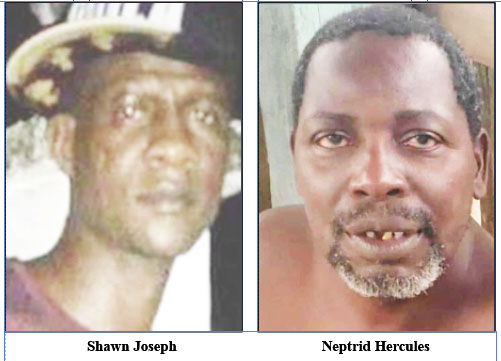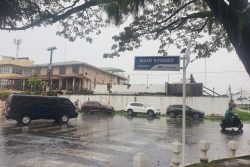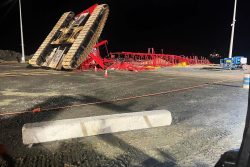By Shuntel Glasgow
The families of two men who died on the job are faced with delays even as they seek justice from the Ministry of Labour and the companies with whom they worked: Tepui Group Inc. and Bosai Mineral Group (Guyana) Inc. (BMGG).
Both fatalities occurred in 2023 and the matters remain with the Ministry of Labour’s Occupational Safety and Health (OSH) department.
The deaths and the slow processes are particularly troubling as the ministry itself recently reported that the number of workplace fatalities this year is up over the same period last year. For deaths that occurred in 2023 there has been little information from the ministry on prosecutions or settlements to families.
Shawn Joseph
Fayeann DoSantos, the mother of Shawn Joseph, a crane operator attached to Tepui Group Inc., told the Stabroek News that the family feels that their interests have been abandoned. Joseph died on October 5th, 2023. DoSantos added that she was not satisfied with the way in which the investigation was being handled. The grieving mother said the family was never formally engaged on the investigation. According to DoSantos, following the incident, Mikhail Rodrigues also called ‘Guyanese Critic’, of Tepui Group, contacted the family regarding funeral expenses. According to the mother, Rodrigues met Joseph’s wife and handed over to her $450,000 along with a receipt. She emphasized that the family was told that the money was to be used only for her son’s burial expenses since his storage was facilitated in Georgetown. The graphic images of the incident were shared with the family and the mother stated that her son’s gruesome death should be treated with importance to bring closure to the grieving family.
DoSantos further refuted claims made by Rodrigues in which he stated that he gave the family $5 million compensation for Joseph’s death. Rodrigues allegedly promised over a four-month period to visit the family for further discussions but when Stabroek News last checked he was yet do so. DoSantos explained, “Almost three something [money] was for the casket and then we had to pay for storage and transportation to come to Berbice and the money done. He [Rodrigues] made a receipt. We lived on promises because he called several times to say he was coming for a discussion. We did not receive compensation…”
Joseph’s death shattered his wife who was dependent on him for the maintenance of their home. While adjusting to a life without her husband, the woman said she has a mortgage and children among other responsibilities to meet. Joseph was crushed to death after he jumped from a crane he was operating as it toppled while planting piles at a construction site at Providence, East Bank Demerara. The family had held high hopes that the Ministry would have conducted a far -reaching investigation into the accident.
According to a press statement to the Stabroek News by Minister of Labour, Joseph Hamilton, in January 2024, a Trinidadian expert in crane operation had joined the Ministry’s Occupational Safety and Health (OSH) team to look into the workplace death at Tepui Group Inc. and offer recommendations.
Neptrid Hercules
Over a year after Bosai bulldozer operator, Neptrid Hercules died after a mining pit collapsed at the East Montgomery Mines in Linden, and covered both Hercules and the crane he was operating, the family is yet to be compensated. While Bosai indicated that the family will be granted access to the funds, Hercules’ son, Kester Hercules, told Stabroek News recently that the family is yet to be compensated. Neptrid Hercules died on March 11, 2023 after earth structure failure at the mine.
Kester explained that they were told that an administrator is now needed for the company to proceed with the transaction. The family has since been exploring for an administrator to help with the process. It is unclear whether Bosai will be held criminally accountable for the worker’s death.
Hercules who was employed by BOSAI Minerals Group Guyana, Linden, Upper Demerara River, went missing in the early hours of March 11, 2023 along with the CAT D9T bulldozer which he was operating at the time. This was due to a land failure experienced at the overburden dump in the East Montgomery Mine where he was working. Several efforts were made to help retrieve Neptrid’s body including the use of steel rods, metal detectors and a magnetometer.
The equipment was discovered by a magnetometer used by the Guyana Geo-logy and Mines Commission (GGMC) personnel and the body was discovered within the excavator following an extensive search. Hercules was employed with the mining company for 42 years.
The Commission of Inquiry into Hercules’ death found culpability not only on the part of the company, but also the Ministry of Labour and respective oversight agencies, as had they been vigilant in their duties and enforced laws of the country, the fatal incident would have never occurred.
The report included a long list of recommendations with timelines for implementation to prevent another occurrence.
The Ministry of Labour had issued a release with some of the recommendations in the report, but there was no word on the overall report findings nor was it stated that a timeframe was advised for the implementation of the recommendations.
The report presented the results of an investigation undertaken, consequent to an earth structure failure on March 11th 2023, of an area being reclaimed by Bosai where Hercules was entombed along with a Caterpillar D9 bulldozer. He had been operating the machine at the time and the report underscored that had certain requisite risk assessments been taken prior, the accident could have been avoided.
“The primary cause… was BMGG’s failure to conduct a risk assessment of the reclamation dump construction methodology. The risk assessment would have identified the possibility of liquefaction simply based on the stratigraphy of the dump and the consequences associated with a highly impermeable layer underlying a loose granular soil with no ability to dissipate ground and surface water inflows into the granular layer. Another contributory factor is BMGG’s failure to address geotechnical engineering/ groundwater hydrology issues in its operations,” the report seen by the Stabroek News stated.
It explained that elementary geotechnical knowledge would recognize that clay would lose strength in undrained load conditions when loaded, but this was never considered by BMGG.
“Reclamation dump operations never integrated any soil strength data into the design, therefore the likelihood of soil strength loss was never considered. BMGG had no monitoring instrumentation in place at the reclamation dump. The development of elevated pore water pressures, warning of the possibility of liquefaction, could have been determined if low technology stand-pipe piezometers were installed in the area. … several minor failures [had] occurred at the reclamation dump previously,” the report highlighted.
“Legislative/regulatory bodies also must bear some culpability for the failure. Application of best technology and risk assessment requirements by the EPA; the Ministry of Labour’s request of BMGG for a report, bearing the seal of a professional engineer that the ground stability would not endanger a worker and GGMC’s application of some of the requirements of the 2005 Mining (Amendments) Regulations may have induced BMGG to incorporate geotechnical engineering and hydrology considerations into the reclamation dump construction,” the report added.
In a stinging rebuke to the company, the report stated that “best practices” such as risk assessments for large-scale operations were never applied by the company and while it had hired an Occupational Health and Safety consultant, that person focused more on public relations than ensuring safety measures were implemented.
The investigation also highlighted that the company also did not have an Emergency Response Plan and thus no noted measures could have been activated on the said day.
According to the report, the failure that day resulted in the displacement of approximately 35,000 cubic meters (m3) of soil and was reflected by significant saturated soil flow to the base of the wall opposite the reclamation area. That saturated soil flow also progressed to the north and east of the mined-out area and was precluded from entering the active mining area by a ramp separating it from the mined area.
“There was failure to identify risks associated with dump construction, consequently an appropriate corrective mechanism could not be applied to dump construction. An Emergency Response Plan, which would have been prepared if a risk assessment was undertaken, was never prepared for the likelihood of reclamation dump failure,” the report said.
Further, it added, “The site visit confirmed the presence of small static liquefaction flows elsewhere around the reclamation dump. This should have alerted BMGG to the likelihood of other failures. BMGG should have considered the increased likelihood of additional failures given the occurrence of these small liquefaction flows coupled with the failure reported by Mr Bacchus and Mr Graham. This confirms the absence of technical oversight of a relatively complex reclamation dump construction.”
‘Negligence’
The report said that BMGG’s actions, after the failure and loss of life, “have indicated no interest in resolving the technical issues and gaps in the design and construction methodology. BMGG continues the dump reclamation operation with practically no changes despite the technical deficiencies having been identified.
“BMGG efforts are more focused on public relations as is evidenced by its hiring of a non-technical consultant. That consultant, Mr Peter Benny, adds no value to BMGG’s ability to develop solutions to the technical deficiencies in the reclamation dump design and construction…”






